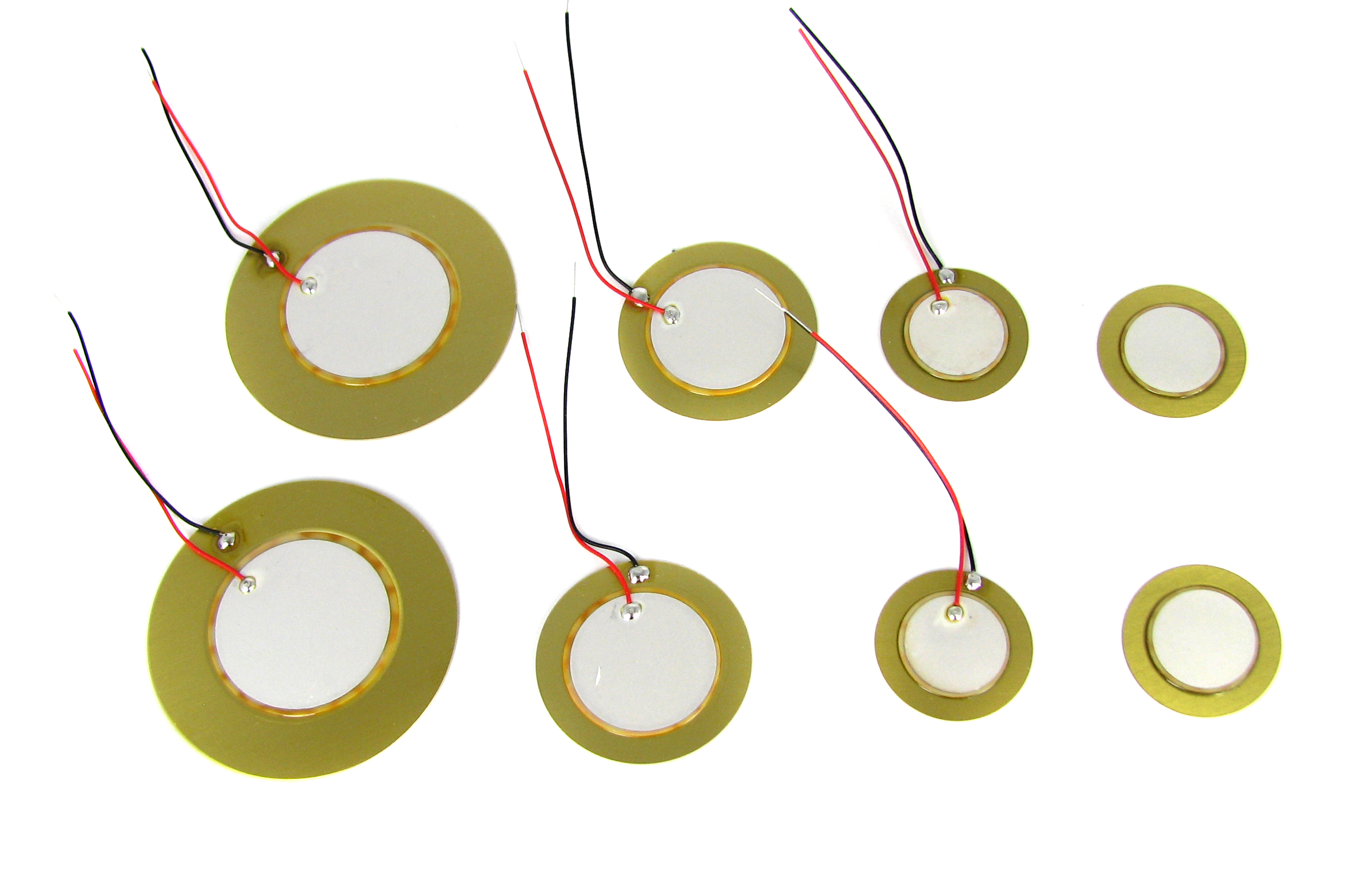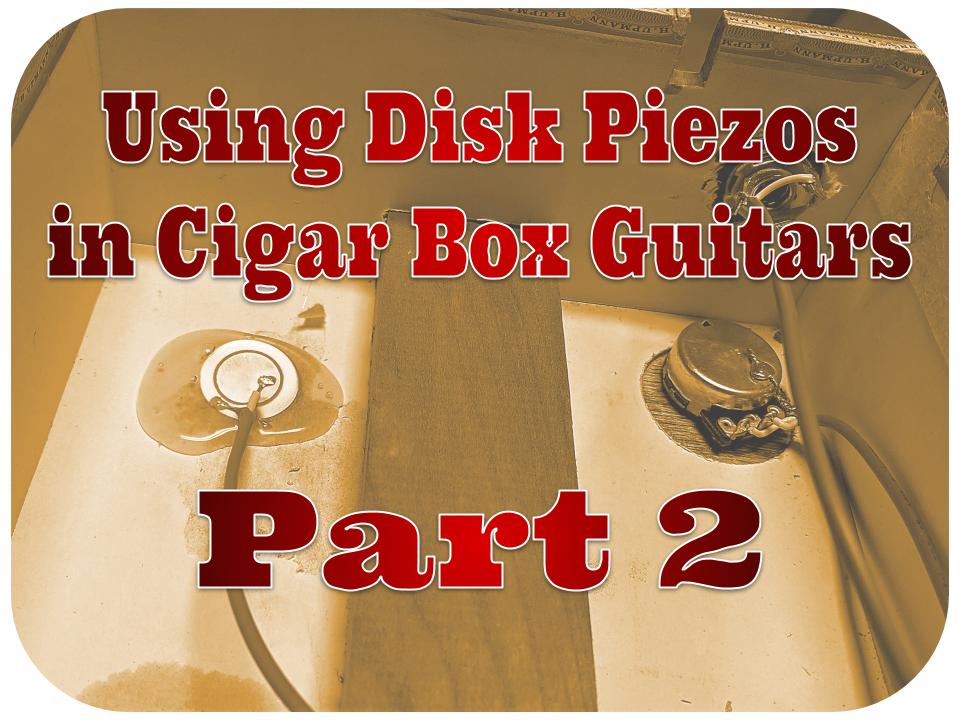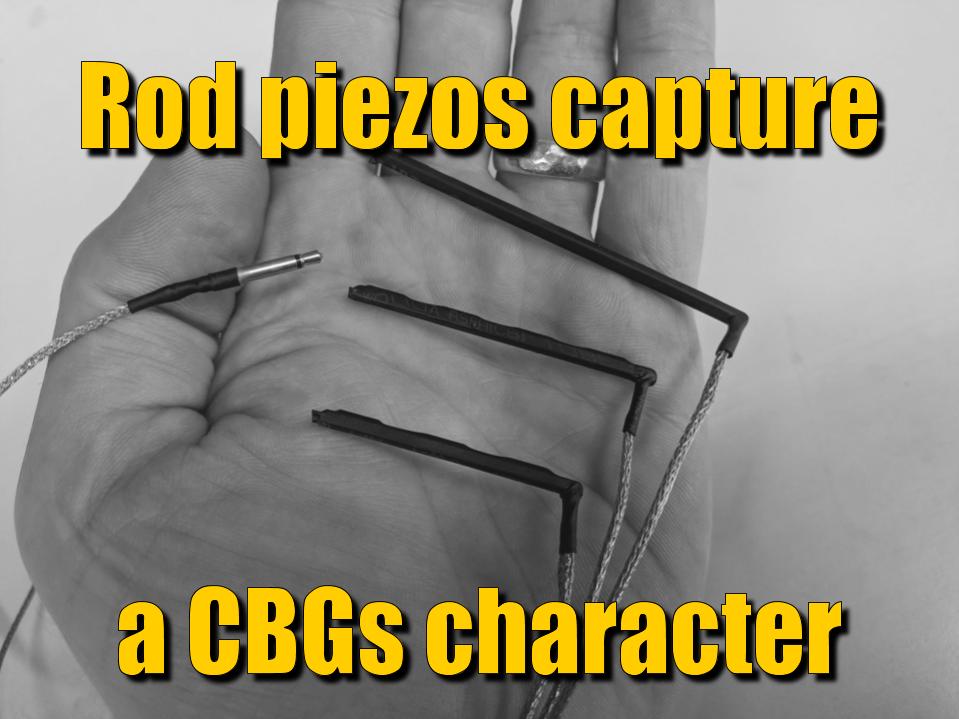Piezo Pickup Basics: Using Disk Piezos In Cigar Box Guitars - Part 1
Are you struggling with how to use a disk piezo pickup in your cigar box guitar? Do want to electrify your CBG with a piezo but don't know where to start?
This is the first article in a two-part series that gives you the bare-bones "here's what you need to know" information to help you install a disk piezo pickup in your next cigar box guitar build.
What You'll Find Here
A lot of new cigar box guitar builders, and more than a few veterans, tend to get a bit uneasy when the topic of piezo pickups comes up.
Everyone seems to have a different idea of how to use them.
Some folk say that they should be built into the bridge while others attach them to the bridge exterior.
Some mount them inside the box lid and others attach them to the outside of the lid.
Add in concepts such as insulation methods, multiple piezos, volume potentiometers and wiring schematics, and the waters tend to get pretty muddy pretty fast.
To help you sort through the mess, what we'll will cover in this article are –
- what a disk piezo is
- which piezo to choose
- and how to solder leads to one
In another article we'll also dive into rod piezos.
But for this topic of disk piezos we'll first address...
What Is A Disk Piezo?

A standard disk piezo consists of a thin metal disk (usually brass, sometimes stainless steel), with a very thin wafer of ceramic glued to it.
Wire leads are soldered to these disks (one to the metal part, one to the ceramic part).
When excited with an appropriate electric current, the interaction between the metal and the ceramic can cause sound to be produced.
Using piezos to create sound, rather than detect sound, is the most common usage of them in manufacturing.
Many devices, from smoke alarms to alarm clocks to children's toys, use piezos as a sort of miniature speaker to produce sound.
Disk Piezos As CBG Pickups
Fortunately for CBG builders, the disk piezo can also be used in a different way: to pick up sound vibrations, which can then be amplified by other circuits such as those in a guitar amplifier.
Basically, the amplifier sends a small current through the piezo element (though not enough current to cause the piezo to MAKE sound).
When the piezo is affected by vibration (such as the vibrations of a guitar sound board when strummed), those vibrations cause the metal and ceramic to interact in such a way that the current is modified.
These fluctuations in the current through the piezo are picked up by an amplifier, increased and reproduced on a larger speaker.
The end result is that we hear our instrument in an amplified form.
There are other types of piezos beyond the metal/ceramic disk we have described, but since that is the most common kind available, it is what we will be discussing here.
Magnetic vs. Disk Piezo Pickups
It's worth pointing out here the difference between a magnetic pickup (like those in electric guitars) and piezos.
Magnetic pickups pick up sound when their magnetic fields are caused to fluctuate by the vibration of steel strings near them.
These fluctuations are increased by an amplifier and reproduced as the familiar electric guitar sound.
A piezo, on the other hand, has nothing to do with magnets: it picks up vibrations only.
In this sense, a guitar with a piezo pickup is really still an acoustic instrument - the acoustic vibrations are just being amplified, in a similar manner to playing into a microphone.
Now that you have a better idea what they are, what kind of disk piezo should you choose?
Choosing A Piezo
Piezoelectric elements (piezos) come in various shapes and sizes: encased vs. unencased, wired vs. unwired, brass vs. stainless steel disks, disk form vs. strip form, etc.
Sizes can range from quite small varieties around 10mm in diameter to very large 50mm disks.
We will discuss each of the key factors below to give you some groundwork to build from when considering what to use on your build.
Size
There tends to be a lot of discussion about what size of disk piezo element is best.
We sell piezos from 20mm to 41mm in our shop, and builders are always asking us which is best.
Opinion on the matter tends to be pretty evenly divided.
Some builders claim that the larger piezos are better at picking up bass tones from an instrument, which would therefore give you a deeper tone and less of the higher treble tones.
Other builders, including Ted Crocker who has worked extensively with piezos and done a great deal of testing, believe that there is no perceivable difference between different sizes of piezos when it comes to using them as instrument pickups.
Our advice is: use what makes you happy.
If a bigger piezo strikes your fancy, or you feel it sounds or works better in your build, then go for it.
If you want to be more economical, go with the smaller piezos.
As with so many things in the cigar box guitar world, there isn't one way to build with disk piezos.
To help you find your way, this article will serve as your compass, but personal experimentation and preference will ultimately be your guide.
Encased vs. Unencased
All of of the disk piezos we sell are the plain, unencased disks, which is how you want them for use in a cigar box guitar.
Radio Shack and other retailers sell piezos (for outrageous prices) which come encased in a plastic housing.
These piezos are manufactured this way because they are intended to be used as sound producing devices, instead of sound detecting devices.
While you can certainly glue or screw the encased piezo - housing and all - right to your build, this is really not recommended.
You will always get much better sound if you mount the unencased piezo in your build, perhaps sandwiching it between some other material (such as leather or thin wood) first.
Cutting the piezo disk out of the plastic encasement can be tricky to do without ruining the element itself, so our advice is to avoid the encased piezos and always buy the plain disks.
Brass Disks vs. Stainless Steel
You don't see the stainless steel disk piezos as much as the brass piezos, but they are out there.
There isn't all that much difference in how the metal affects their behavior as a pickup, but what the stainless steel does do is make it a lot harder to solder wires to them.
In our opinion, trying to solder to stainless is simply not worth the time and effort.
Stick with brass disks and you will be much happier.
All of the piezos we carry in our online store have brass disks.
Wired vs. Unwired Disks
In C. B. Gitty online store we offer most sizes of disk piezos we carry in both pre-wired and unwired form.
The only difference is that the pre-wired piezos have 2-inch leads soldered to them already, while the unwired ones are just the plain disks.
While soldering leads to piezos is not hard, it can be a pain for people without much soldering experience, or without a good solder station setup.
As such, many folks prefer to get the pre-wired ones.
It should be noted however that the 2-inch wires are really not long enough for attaching the piezo directly to a jack, so you usually have to attach extender wires anyway, whether with solder (preferred) or tape.
Looking for some disk piezos of your own?
How To Solder A Piezo
To solder lead wires to a disk piezo, choose a generous length of thin-gauge insulated copper wire and start off by stripping off about 1/8" of insulation.
Then twist the strands of each wire together firmly (assuming a multi-strand copper wire).
Now heat the wire and apply a small amount of a good electrical solder to it.
This is called "tinning" the wire, and is always recommended to make the later soldering process much easier.
Now apply two small beads of solder to the piezo disk: one to the metal portion, and one to the ceramic portion.
Be sure that you don't connect the brass and ceramic with solder, as this will short out your piezo.
The size of the beads should be as small as you can make them, but big enough that there will be enough to surround your wire lead.
Now take the stripped, tinned end of one of your leads and place it against one of the solder beads.
Touch the soldering iron tip to it, and hold it just until the solder melts and the wire sinks into the bead.
Immediately remove the heat and hold the wire steady for a few seconds while the solder hardens.
Resist the urge to blow on it - it will form a stronger bond if it cools at its own pace.
Repeat this process for the second lead, and you should be all set.
Conclusion
This ends Part 1 of this two-part series.
In Part 2 we will get more of the nitty gritty "need-to-know" information regarding WHERE to mount a piezo in your build, as well as HOW to mount it.
Now, after all that you're probably looking for some piezos to electrify your next build.
What will your disk piezo-electrified cigar box guitar sound like?
Must Reads
Now that you're done with part 1, head on over to finish this 2-part piezo pickup basics series.
Piezo Pickup Basics: Using Disk Piezos In Cigar Box Guitars - Part 2
Confused about where in your cigar box guitar to install a disk piezo pickup? Or perhaps how to install one?
Those questions and more are answered in this second article of a two-part series about using disk piezos in cigar box guitars.
Click here to dive into part 2 Piezo of Pickup Basics: Using Disk Piezos In Cigar Box Guitars.
After mastering disk piezo pickups, check out this article about rod piezos...
What's A Rod Piezo & Why Use One In Your Cigar Box Guitar?
What exactly is a rod piezo? And why should you consider using one to electrify your next cigar box guitar build?
After reading this instructive article, you’ll gain the confidence to build with rod piezos, thereby raising the level all your future electric cigar box guitar builds.
Click here to discover the power of rod piezos.
Recent Posts
-
2024 World's Wildest Electric Cigar Box Guitar Build-Off Winners!!!
C. B. Gitty Crafter Supply is proud to announce the winners of the 2024 "World's Wildest Electric Ci …31st Oct 2024 -
Improved C. B. Gitty: Easier Than Ever! (Work in Progress)
Ben “Gitty” has been cleaning house, making our website even easier find your favorite parts, kits a …7th Oct 2024 -
Build-Off Contest 2024: The World's Wildest ELECTRIC Cigar Box Guitar
CBGitty.com is looking for the WILDEST, LOUDEST & MOST DIABOLICAL electric cigar box guitar ever …6th Sep 2024






